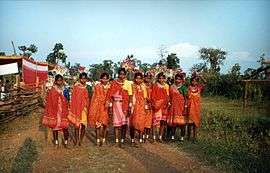Bhil people
 | |
| Regions with significant populations | |
|---|---|
| Gujarat | 3,441,945[1] |
| Madhya Pradesh | 4,619,068[2] |
| Maharashtra | 1,818,792[3] |
| Rajasthan | 2,805,948[4] |
| Pakistan | 382,000 |
| Languages | |
|
Bhil languages Marathi Gujarati | |
Bhils or Bheel are primarily an Adivasi people of North West India. Bhils are also settled in the Tharparkar District of Sindh, Pakistan. They speak the Bhil languages, a subgroup of the Western Zone of the Indo-Aryan languages. According to Census, 2001, Bhils were the largest tribal group in India followed by Gond tribe.[5]
Bhils are listed as Adivasi residents of the states of Gujarat, Madhya Pradesh, Chhattisgarh, Maharashtra and Rajasthan - all in the western Deccan regions and central India - as well as in Tripura in far-eastern India, on the border with Bangladesh. Bhils are divided into a number of endogamous territorial divisions, which in turn have a number of clans and lineages. Most Bhils now speak the language of the region they reside in, such as Marathi and Gujarati. They mostly speak a dialect of Hindi.[6]
Present circumstances
In Gujarat and Maharashtra, the Bhil are now mainly a community of settled farmers, with a significant minority who are landless agricultural labourers. A significant subsidiary occupation remains hunting and gathering. The Bhil are now largely Hindu, with Nidhi and Tadvi Bhil following Islam, and few sub-groups in the Dangs following Christianity. They continue to worship tribal deities such as Mogra Deo and Sitla Matta.[7][8]
The Bhil are classified as a Scheduled Tribe in Andhra Pradesh, Chhattisgarh, Gujarat, Karnataka, Madhya Pradesh, Maharashtra, Rajasthan and Tripura under the Indian government's reservation program of positive discrimination.[9]
Sub-divisions of the Tribe~
The Bhil are divided into a number of endogamous territorial divisions, which in turn have a number of clans and lineages. The main divisions in Gujarat are the Barda, Dungri Garasia, and Vasava, while in Maharashtra, the Bhil Mavchi and Kotwal are their main sub-groups.[7]
In Rajasthan, they exist as Bhil Garasia, Dholi Bhil, Dungri Bhil, Dungri Garasia, Mewasi Bhil, Rawal Bhil, Tadvi Bhil, Bhagalia, Bhilala, Pawra, Vasava and Vasave.[10][lower-alpha 1]
Culture
The Bhilala subclan is known for its Pithora painting.[11]
The Ghoomar dance is one well-known aspect of the Bhil culture.
Images
-

Bhil tribal boys in Jhabua
-

Bhil girl in Raisen district, MP
-

Bhil woman in Raisen district, MP
-

Bhil woman in Raisen district, MP
-

Bhil woman in Raisen district, MP
See also
References
Notes
Citations
- ↑ "Gujarat: Data Highlights the Scheduled Tribes" (PDF). Census of India 2001. Census Commission of India. Retrieved 2008-03-31.
- ↑ "Madhya Pradesh: Data Highlights the Scheduled Tribes" (PDF). Census of India 2001. Census Commission of India. Retrieved 2008-03-06.
- ↑ "Maharashtra: Data Highlights the Scheduled Tribes" (PDF). Census of India 2001. Census Commission of India. Retrieved 2008-03-31.
- ↑ "Rajasthan: Data Highlights the Scheduled Tribes" (PDF). Census of India 2001. Census Commission of India. Retrieved 2008-03-31.
- ↑ Demographic Status of Scheduled Tribe Population of India, Minitry of Tribal Affairs, India
- ↑ People of India Gujarat Volume XXII Part One edited by R.B Lal, S.V Padmanabham & A Mohideen page 214 to 251 Popular Prakashan
- 1 2 People of India Gujarat Volume XXII Part One edited by R.B Lal, S.V Padmanabham & A Mohideen page 214 to 221 Popular Prakashan
- ↑ People of India Maharashtra Volume XXX Part One edited by B.V Bhanu, B.R Bhatnagar, D.K Bose, V.S Kulkarni and J Sreenath pages 280–286
- ↑ "List of notified Scheduled Tribes" (PDF). Census India. Archived from the original (PDF) on 7 November 2013. Retrieved 15 December 2013.
- ↑ "List of Scheduled Tribes". Census of India: Government of India. 7 March 2007. Archived from the original on 5 June 2010. Retrieved 27 November 2012.
- ↑ Pachauri, Swasti (26 June 2014). "Pithora art depicts different hues of tribal life". Indian Express. Retrieved 13 February 2015.
External links
| Wikisource has the text of the 1911 Encyclopædia Britannica article Bhils. |
| Wikimedia Commons has media related to Bhil people. |
- Gond & Bhil Tribal Art — Madhya Pradesh.
- The desert dwellers of Rajasthan: Bishnoi and Bhil peoples (essay)
- Bhil Tribe In Rajasthan
- Genetic Affinity of the Bhil, Kol and Gond Mentioned in Epic Ramayana
